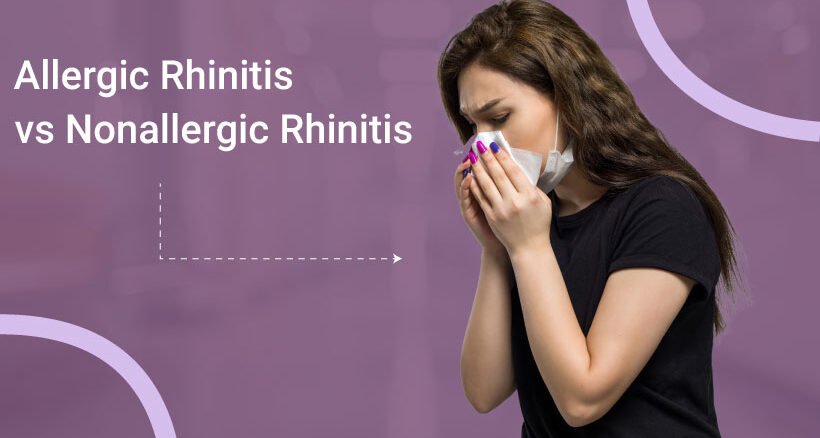If you constantly find yourself sneezing, dealing with a runny or blocked nose, or feeling congested without a cold in sight, you might be suffering from rhinitis. Many people are unaware that rhinitis can be classified into two main types: allergic and non-allergic. Understanding the differences is crucial for effective treatment and long-term relief.
As an ENT specialist in Ahmedabad, Dr. Simple Bhadania often experience patients who are unaware of the type of rhinitis they have. In this blog, let’s explore how allergic and nonallergic rhinitis differ in causes, symptoms, diagnosis, and treatment so you can breathe easier and manage your health better.
What is Rhinitis?
Rhinitis refers to inflammation of the nasal lining, resulting in symptoms like nasal congestion, sneezing, a runny nose, and postnasal drip. While the symptoms of allergic and nonallergic rhinitis often look similar, their underlying causes and treatment strategies vary.
Knowing whether you have allergic or nonallergic rhinitis helps in selecting the right treatment and avoiding unnecessary medications.
What is Allergic Rhinitis?
Allergic rhinitis is an immune system response to allergens, substances your body mistakenly identifies as harmful.
Causes and Common Allergens:
- Pollen from trees, grasses, and weeds (common in seasonal allergic rhinitis or “hay fever”)
- Dust mites
- Pet dander
- Mold Spores
- Cockroach droppings
Triggers:
- Being outdoors during high-pollen seasons
- Cleaning dusty rooms
- Exposure to pets
- Sleeping on unwashed bedding or pillows
Common Symptoms of Allergic Rhinitis:
- Frequent sneezing
- Itchy nose, eyes, or throat
- Runny nose with clear discharge
- Nasal congestion
- Watery, red, or itchy eyes
- Postnasal drip
- Fatigue (due to disturbed sleep)
Symptoms may occur seasonally (in response to outdoor allergens) or year-round (due to indoor allergens).
What is Nonallergic Rhinitis?
Nonallergic rhinitis is not triggered by allergens or immune responses. Instead, it’s caused by environmental irritants or internal body factors.
Causes of Nonallergic Rhinitis:
- Strong smells (perfumes, cleaning agents)
- Smoke or air pollution
- Weather changes (cold air or humidity)
- Hormonal changes (pregnancy, menstruation, thyroid issues)
- Medications (nasal decongestant overuse, blood pressure drugs)
- Spicy foods or alcohol
Symptoms of Nonallergic Rhinitis:
- Runny nose
- Nasal congestion
- Postnasal drip
- Sneezing (less frequent than in allergic rhinitis)
- No itching of eyes or throat
Nonallergic rhinitis can occur suddenly, even without a known trigger, and may persist throughout the year.
Key Differences Between Allergic and Nonallergic Rhinitis
| Feature | Allergic Rhinitis | Nonallergic Rhinitis |
| Cause | Allergens (pollen, dust mites, etc.) | Irritants (smoke, weather, perfume) |
| Immune System Involvement | Yes | No |
| Seasonal Pattern | Often seasonal or year-round | Usually year-round |
| Age of Onset | Usually before age 30 | Common after age 30 |
| Common Symptoms | Sneezing, itchy eyes/nose/throat | Nasal congestion, runny nose |
| Eye Symptoms | Often present | Rare |
| Allergy Testing Result | Positive | Negative |
Here’s a quick comparison to help you spot the differences:
How is Rhinitis Diagnosed?
Accurate diagnosis is the first step toward relief. Dr. Simple Bhadania recommends the following evaluation:
Medical History:
- Type and frequency of symptoms
- Exposure to potential triggers
- Seasonal variation or year-round pattern
Physical Examination:
- Inspection of nasal passages and sinuses
- Looking for signs of inflammation, Nasal polyps, or a deviated septum
Allergy Testing:
- Allergies can be identified through either a skin prick test or a blood test that measures IgE antibodies.
- Helps differentiate allergies from nonallergic rhinitis
Nasal Endoscopy or Imaging (if needed):
- To rule out structural issues or chronic sinusitis
Treatment and Management Options For Allergic Rhinitis:
Avoid Allergen Exposure
- Use dust-mite-proof covers
- Keep windows closed during high-pollen days
- Wash pets regularly
Medications
- Antihistamines
- Intranasal corticosteroids
- Decongestants (short-term use only)
- Leukotriene receptor antagonists
Immunotherapy (Allergy Shots/Tablets)
- Long-term solution for severe or persistent allergy cases
Treatment and Management Options For Nonallergic Rhinitis:
Identify and Avoid Triggers
- Minimise exposure to smoke, pollution, and strong odours
- Avoid spicy food or alcohol if they cause symptoms
Medications
- Intranasal corticosteroids
- Anticholinergic nasal sprays (e.g., ipratropium bromide)
- Saline nasal sprays for regular rinsing
Lifestyle Modifications
- Use humidifiers in dry weather
- Practice nasal irrigation (under medical guidance)
Prevention Tips for Both Types of Rhinitis
- Keep indoor air clean using HEPA filters
- Regularly clean bed linens and curtains
- Bathe after outdoor exposure during pollen season
- Avoid smoking and secondhand smoke
- Limit use of nasal decongestants to avoid rebound congestion
- Stay hydrated and maintain good nasal hygiene
When to See an ENT Specialist
You should consult an ENT specialist like Dr. Simple Bhadania if:
- Your symptoms persist despite over-the-counter medications
- You have frequent sinus infections or facial pain
- You are unsure whether your rhinitis is allergic or nonallergic
- Your quality of life is affected by your nasal symptoms
Proper diagnosis and treatment can significantly improve your daily comfort and long-term health.
Conclusion
Both allergic and nonallergic rhinitis can disrupt your daily life with similar nasal symptoms, but their causes and treatments differ significantly. Identifying your specific type is essential for achieving long-term relief. Don’t let a runny nose or congestion slow you down.
For ongoing rhinitis symptoms, consider booking an appointment with ENT specialist Dr. Simple Bhadania, who offers expert evaluation and tailored treatment plans.
Book your appointment today and breathe freely again!
Dr. Simple Bhadania – Expert ENT care with a heart, focused on lasting relief.


